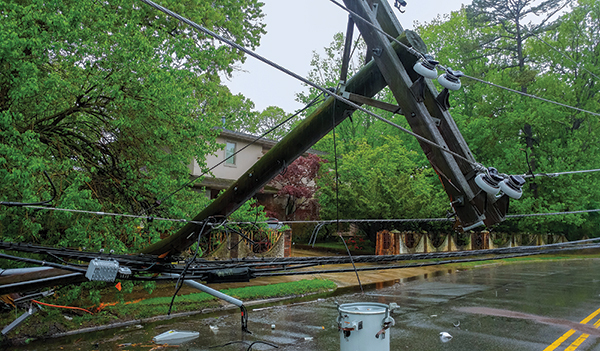More than ever before, utilities are under pressure to tackle the threats that severe weather poses to their operations and bottom lines. The U.S. Department of Energy (DOE) has stated power outages cost more than $150 billion annually, so it’s important for utilities to manage, not only the safety and comfort of customers, but also for the bottom line. Volatile weather is an ongoing challenge for utilities, and many are learning that innovative machine learning approaches can be a great fit for improving storm preparation.
It’s challenging to make the perfect preparation decision, but recent advances in weather artificial intelligence (AI) are helping utility companies support their power outage predictions by allowing them to forecast outages and not just weather as has traditionally been the case.
Industry challenges
Collaborative preparation is required to recover from a storm quickly and efficiently. It may be as simple and short-term as a holdover decision or deciding how many crews to have on call the night of a storm. Or, it may be as major as a mutual assistance request three or four days in advance of an impending hurricane. Either way, preparation is critical to avoid being under- or over-prepared for a storm, both of which can be very costly.
Being underprepared can have various negative impacts. Long restoration times, due to inadequate staffing or materials, can be disastrous. With many media outlets and social-media channels forecasting outages along with the weather, stakeholders are quick to review if a particular utility was adequately prepared.
Utilities are constantly scrutinized, needing to justify all of their operational decisions during significant weather events. As public tolerance for major outages decreases substantially, growing regulatory and political review can lead to denied cost recovery or other forms of penalty.
Being over-prepared also is costly. Today, many utilities are operating with leaner organizational structures, meaning outside resources are being used more frequently for significant weather events. Mobilizing assistance is costly and can be inefficient if that assistance is underutilized or redirected.
Managing the outages related to major weather events is important to customer satisfaction, operational costs, avoiding penalties from regulators and the company’s image. Better prediction methods can only help restoration plans be better received by both utility management and outside parties.

Evolution of outage prediction
Current approaches to storm preparation include looking at weather forecasts and calling on experience as to how similar storms impacted the utility. There’s been a heavy reliance on personal experiences with past weather events. As new generations of utility staff are hired and experienced employees retire, this can leave a gap in knowledge.
Consulting with meteorologists is also a widely used tactic, which helps greatly in understanding risk. The weather forecast may even be given a numerical storm categorization — where each storm is given a rating for the level of impact on the utility’s service territory. That’s good, but not enough. An understanding of the damage that can result is needed to gauge preparatory actions. Some utilities have employed statistical techniques — looking at past analog storms and the effects — to try to begin to estimate the potential impact on infrastructure. While better, these simple statistical methods are crude and not very effective. For example, a utility may try to do a regression analysis on wind speed versus outages, which is very over-simplified.
What’s a better way? A promising new approach is machine learning. Whether you call it machine learning, artificial intelligence, or neural network algorithms, this is emerging as a more sophisticated approach to predicting damage and outages.
With the growing application of machine learning in business — from streaming content services recommending products and services based on one’s browsing habits, to a manufacturer estimating equipment time to failure — it could be a particularly good fit for the utility damage prediction model.
Machine learning uses history to identify patterns that enable future prediction of outages. Every utility is different, with different designs, age, maintenance practices and so on. Two utilities will be impacted differently by the same weather. In fact, different areas of one utility may respond very differently to the same storm. Machine learning can quite literally learn those differences.
Utilities are realizing that when weather forecasts are used in conjunction with other data, they can create quantitative predictions, including an estimate of the outage incidents in a utility’s service territory, before a storm’s arrival.
It’s all about the data
What’s needed to apply machine learning? A key to machine learning is providing the right, high-quality data to train the machine learning models that do the prediction. There are a variety of factors to look at in addition to weather forecasts:
- Historical outage incident information from the utility that is both time-stamped and geo-located (e.g., latitude and longitude). Typically, three to five years of outage incidents (trouble spots) are required to train the models adequately, but in general, the more data, the better.
- Historical weather information corresponding to a utility’s weather-related outages. This also needs to be very high -resolution data.
- Utility’s overhead distribution system data in geospatial form. It’s important for the machine learning to know where poles, lines and isolating (protective) devices are located. A simple example illustrates why this is important: the more lines a utility has in an area, the more likely it is there will be a problem.
- Factoring in trees to determine where they are in proximity to lines, and when the spring/fall leaf changeover occurs for deciduous trees. This can be further supported with annual and enhanced trimming data.
This data is then leveraged to build predictive damage models specific to each type of weather event (e.g., thunderstorms, snow, wind, hurricanes, etc.). These models can then be used going forward to predict the impact of future storms based on forecasted weather.
In reality, there will be a number of predictive models used for the type of storm expected. Different machine learning algorithms are then aggregated together to get a range of potential incidents on a utility’s territory.
Machine-learning technology can determine where outages will be throughout a utility’s entire network, identifying areas that will be most affected, allowing operations teams to better plan for staging, pre-positioning, or simply alerting local crews. It also can provide useful resiliency insights, highlighting areas of weakness, as illustrated by outage incident history and the damage forecasts themselves.
As exciting as machine learning is, you can start to see that the devil is in the details. It’s not a simple process; however, the good news is that vendors have built solutions, specifically for the damage prediction problem, that can be applied to a specific utility. Utility staff doesn’t have to be an expert in the machine learning, the unique weather requirements, the needed third-party data sources or the specialized data processing.
Validating predictions before the storm
If utilities are going to begin to leverage machine learning to support critical decisions, they need to understand the reliability of its predictions. One significant benefit of machine learning is its ability to validate the accuracy of a model before putting it into operation; that’s due to cross-validation techniques. For example, let’s say that a wind event model has been built with information from 100 previous storms. In order to cross-validate the model, a utility rebuilds the model to include storm and outage information from 99 of the 100 storms, leaving out the 100th storm. The model is then run against that 100th storm. The model has no knowledge of the storm, and it is just as though it is generating a prediction for forecasted weather. Then, this process is repeated to create a prediction for a second storm, rebuilding the model with the other 99 storms. This step is repeated for every one of the 100 storms, and accuracy metrics are compiled.
By doing this, you can begin to understand how accurate a model is as if it’s had years of experience. This cross-validation also identifies the strengths and weaknesses of the prediction system. For example, one issue might be that there’s not enough data for a particular type of storm, such as a hurricane. As more data is accumulated, the model can be retrained with the latest storm data, including rare events like hurricanes. The more data collected, the more reliable the forecasts become.
Utilities continue to grow and leverage machine learning and can now compare the forecasted effects to customers across the entire system, as well as at the state level. This helps support faster and meaningful decisions on overall restoration strategies.
Machine learning can provide an effective prediction of a storm’s impact and projected damage. This predictive information will continue to grow as a major driver in preparation decisions, and its contributions to decision making in terms of a utility’s overall restoration response. Using machine learning can help a utility hit the right levels of preparation before the storm, reducing the frequency of being under- or over-prepared. The time is now for utilities to use these decision-support technologies that can change the way of doing business for the better.

Don Leick is senior product manager for DTN’s weather business. Leick leads the future direction and enhancement of online, mobile and alerting products. He also leads efforts around the Storm Impact Analytics product, a machine learning-based outage prediction solution for utilities. Leick extensive experience working with many of DTN’s customer segments including utilities, wind farms, sports, and winter road maintenance.







